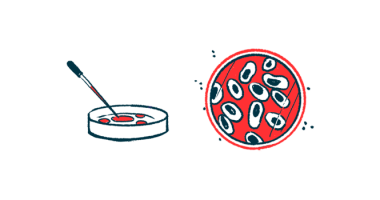DEC Cell Therapy Leads to Muscle Function, Dystrophin Gains in Mice
by |

Treatment with dystrophin expressing chimeric (DEC) cells was safe and led to long-term cellular and functional improvements in the heart, respiratory, and leg muscles of a mouse model of Duchenne muscular dystrophy, a study found.
The findings support “future clinical application of DEC as a safer and potentially more efficacious therapeutic approach applicable to all DMD patients,” the researchers wrote.
The study, “Long-Term Protective Effect of Human Dystrophin Expressing Chimeric (DEC) Cell Therapy on Amelioration of Function of Cardiac, Respiratory and Skeletal Muscles in Duchenne Muscular Dystrophy,” was published in Stem Cell Reviews and Reports.
DMD is caused by the loss of a protein critical for muscle strength, called dystrophin, due to mutations in the DMD gene. As a result, DMD patients have progressive muscle wasting that affects walking, heart function, and breathing.
Cell-based therapies involve transplanting healthy muscle cell precursors to regenerate damaged muscles. While they show promise, it’s not uncommon for patients to have immune reactions to the donor cells, limiting their therapeutic potential. Immunosuppressive treatments to curb these reactions are also accompanied by significant side effects.
Dystrogen Therapeutics is developing an experimental cell therapy for DMD that could bypass these limitations, called DEC cells.
Briefly, the approach involves fusing myoblasts — muscle cell precursors — from a healthy donor source with those from a DMD patient. When delivered to the patient’s bone marrow, the healthy myoblasts allow the production of normal muscle fibers that can produce dystrophin, while the patient’s own myoblasts prevent an unwanted immune reaction against the transplant and eliminate the need for supportive immunosuppressive therapies.
“DEC therapy does not require immunosuppression, is not limited to the specific gene mutation, does not cause immune sensitization and as such is universal for all DMD patients,” the research team wrote.
DEC cells have been shown to increase dystrophin levels and improve cardiac function in a mouse model of DMD after 90 days (about three months) after treatment, but the longer-term effects of DEC cells have not been established.
The research team involved in developing the DEC technology evaluated the effects of the therapy for 180 days in a DMD model prior to severe disease progression, which is marked by heart disease and lung failure.
Mice received one of two doses of human DEC cell treatment or a control injection directly into the bone marrow. The injections were well tolerated, with no signs of inflammation, infection, or internal bleeding at the injection site and no side effects over six months.
The team evaluated the treatment’s effects on three muscle groups significantly involved in DMD progression: the heart, the diaphragm — which is involved in breathing — and the gastrocnemius, a key leg muscle.
Results showed the therapy led to significantly increased dystrophin levels in all three muscles compared with the control injection group.
Both DEC doses also led to significantly fewer areas of inflammation and less fibrosis, or scarring, in the three organs after six months compared with the control group.
DEC cells also mitigated other signs of muscle abnormalities characteristic of DMD, including more normal muscle diameters. Treated mice also had fewer centrally nucleated muscle fibers within the diaphragm and gastrocnemius muscles than untreated mice. While in healthy, mature muscle fibers, the cell’s nucleus, or core, is positioned in the periphery, a more central location is a sign of an immature fiber and is seen in DMD.
DEC treatment also led to functional improvements in all three muscles. Echocardiography, a heart test, revealed that while untreated mice had significant declines in heart function over six months, DEC treatment led to significant improvements.
Similarly, DEC-treated mice saw improved respiratory function and function of the gastrocnemius muscle after six months compared with untreated mice.
The findings support the safety and effectiveness of DEC cells for the long-term treatment of DMD, the researchers said.
“It is estimated that based on this study the conversion of the age of mice to humans corresponds to the human age span from children to adults (7–20 years) and covers the age of DMD patients which will be considered in the future clinical trials,” the researchers wrote, noting their findings are encouraging as they might be “relevant to the outcomes of future clinical studies in the DMD patients.”
In an ongoing Phase 1 trial, Dystrogen is testing the safety and effectiveness of its lead DEC candidate, DT-DEC01, in 10 boys ages 5-18 with DMD.
One study author is founder and chief scientific officer at Dystrogen Therapeutics, which holds a license for DEC therapy. Another is an adviser to the company.








